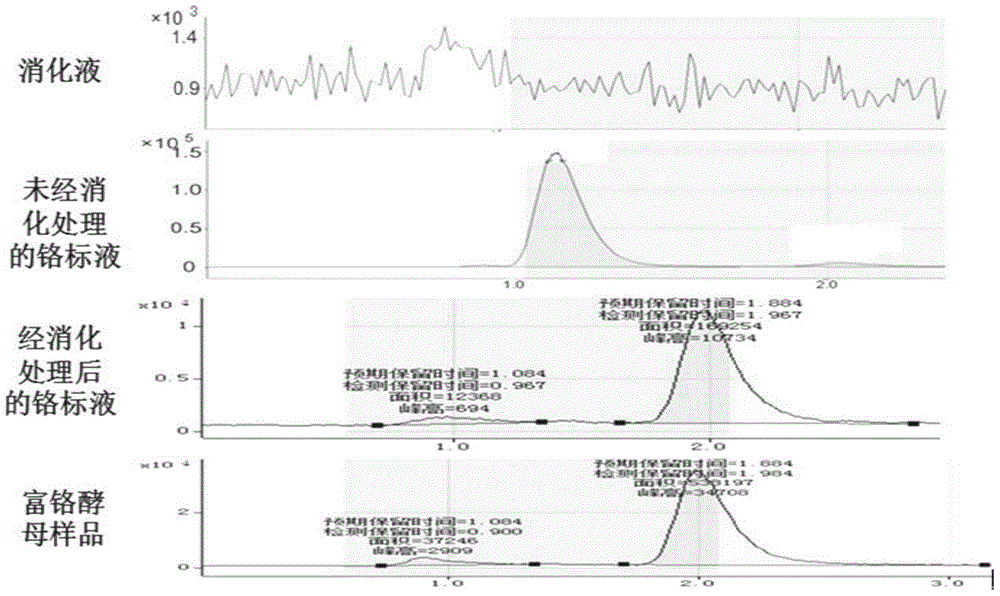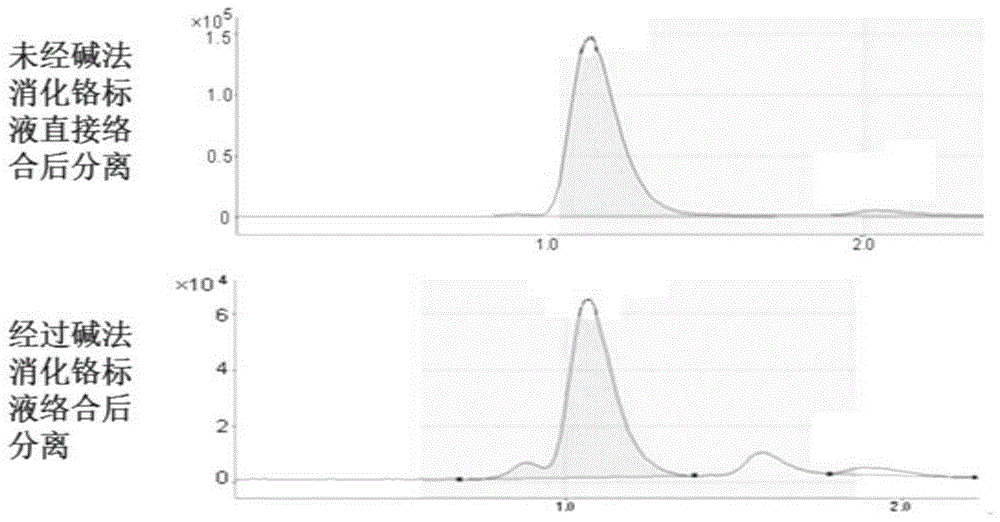A method for quantitatively detecting the valence state and content of chromium in chromium-containing substances
A technology for quantitative determination of chromium content, applied in the field of analysis, can solve the problem of inability to accurately measure the content of chromium elements in different valence states of chromium-enriched yeast cells, and achieve the effects of shortening measurement time, fast speed, and avoiding reduction.
- Summary
- Abstract
- Description
- Claims
- Application Information
AI Technical Summary
Problems solved by technology
Method used
Image
Examples
Embodiment 1
[0042] Example 1. Separation of Cr(III) and Cr(VI) in liquid samples and optimization of detection methods.
[0043] 1) Make the standard curve of total chromium:
[0044]With the concentrations of Cr(III) and Cr(VI) being 0.1, 0.5, 1, 5, 10, 50 and 100 μg / l respectively, and the molar ratio of Cr(III) and Cr(VI) being 1 as the standard sample, the The standard sample is quantitatively determined by ICP-MS to obtain chromatograms corresponding to different total chromium contents, with the total chromium content as the independent variable and the corresponding peak area as the dependent variable to obtain the standard curve of the total chromium content in the standard sample;
[0045] 2) Make Cr(III) and Cr(VI) standard curves:
[0046] The aforementioned standard samples were treated with EDTA Na at a concentration of 5 mM and pH 7.0 2 The aqueous solution is used as a chelating agent for chelation, the chelation temperature is 75°C, and the chelation time is 3h, and then...
Embodiment 2
[0051] Embodiment 2, establishment of valence state analysis method of solid sample chromium element
[0052] Since solid samples need to be digested by alkaline method before separation and determination, it is necessary to detect the influence of alkaline digestion and chelation treatment on sample separation and detection.
[0053] 1. The effect of alkaline digestion on the separation and determination of Cr(VI) in the sample.
[0054] Draw 20μg / l Cr(III) standard solution and 1μg / l Cr(VI) standard solution into a clean Erlenmeyer flask, accurately measure 5ml digestion solution, 0.04g MgCl 2 and 0.05ml of phosphate buffer solution with a concentration of 1.0M and a pH value of 7.0, continuously stirred the sample at room temperature for 5 minutes, then heated the sample to 95°C and maintained it for 60 minutes, then gradually cooled to room temperature, and continued to stir the sample during the process. Centrifuge at 4000g for 5 minutes to take the supernatant, wash the...
Embodiment 3
[0068] Embodiment 3, the determination of chromium element valence state in chromium-enriched yeast cell
[0069] 1) A Saccharomyces cerevisiae strain containing 0 μg / ml, 200 μg / ml, 400 μg / ml and 600 μg / ml Cr respectively 3+ (Chromium acetate) YEPD medium (glucose 20g / l, yeast powder 10g / l, peptone 20g / l) at 200rpm, 30°C for 24hr. Yeast cells were collected by centrifugation at 3000 g for 10 min, washed with deionized water until no chromium ions were detected in the eluate, and dried in an oven at 60°C to constant weight. Weigh 0.03g yeast stem cells, accurately measure 5ml alkaline digestion solution, 0.04g MgCl 2 and 0.05ml of phosphate buffer solution with a concentration of 1.0M and a pH value of 7.0. Stir the sample continuously at room temperature for 5 minutes, then heat the sample to 95°C and maintain it for 60 minutes, then gradually cool to room temperature. During the process, the sample is continuously stirred, and the supernatant is taken by centrifugation at 40...
PUM
| Property | Measurement | Unit |
|---|---|---|
| pore size | aaaaa | aaaaa |
| volume | aaaaa | aaaaa |
Abstract
Description
Claims
Application Information
 Login to View More
Login to View More - R&D
- Intellectual Property
- Life Sciences
- Materials
- Tech Scout
- Unparalleled Data Quality
- Higher Quality Content
- 60% Fewer Hallucinations
Browse by: Latest US Patents, China's latest patents, Technical Efficacy Thesaurus, Application Domain, Technology Topic, Popular Technical Reports.
© 2025 PatSnap. All rights reserved.Legal|Privacy policy|Modern Slavery Act Transparency Statement|Sitemap|About US| Contact US: help@patsnap.com



